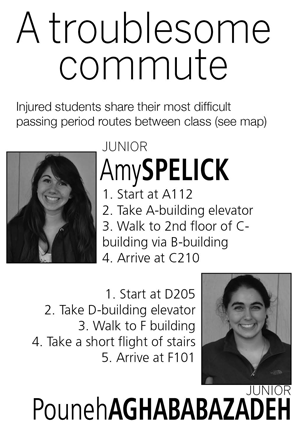For the average student, the trip between the D-building and C-building may look like a short one. But for injured kids on campus, itís a different story.
To make this same trip, they must detour to the far-away A-building, take an elevator, and then walk — or hobble —across several crowded bridges before they can get to their class, all in a 5-minute passing period.
The campus has five two-story buildings: the A-building, B-building, C-building, D-building, and gym. The first three buildings are connected by bridges. Only the A-building, D-building, and gym have an elevator.
With so many injured kids on campus right now, this arrangement can make it difficult for students to get around quickly. Though the routes may be inconvenient, all areas on campus are handicap accessible.
Aside from caring about the well-being of its students, there’s a reason MVHS’s campus is handicap accessible. By law, it has to be.
According to Facilities Manager Chris Kenney, all upgrades on MVHS’s campus must follow Americans with Disabilities Act requirements. Evidence of its guidelines can be seen all around the school.
Most students are aware of the ramps, elevators, and handicap bathrooms around campus. But they may not realize that every science classroom has a table thatís higher than the others to accommodate students in wheel chairs. Few know that the pool has special handicap lifts to provide access to the entire student body. Even the ground has to be a specific grade to be approved by Division of the State Architect inspectors.
Junior Pouneh Aghababazadeh fractured her fifth metatarsal last fall and returned this year with crutches and a walking boot because it failed to heal. Overall, she feels that the school is fairly accommodating. Aghababazadeh also took classes at De Anza College, which, in her opinion, had facilities less handicap accessible than those at MVHS.
“There was a lot of construction,”Aghababazadeh said. “I had to walk up hills to get to all of my classes and down a hill to get to my lecture. All while trying to walk on crutches.”
However, she feels that MVHS would be a lot easier to get around with the addition of another elevator or a bridge between the D-building and C-building.
The administration has looked into constructing a bridge between the C-building and D-building to make routes shorter for students. However, remodeling the lower B-building bathroom and Cafeteria are higher priorities. Also, the cost was estimated to be about a million dollars, so it is unlikely to be built.
Like Aghababazadeh, junior Amy Spelick, who tore her ACL playing soccer, feels that the campusís arrangement can be annoying at times, but the school has been willing to help, making her experience a little less difficult. She has had trouble getting to some of her classes on time, especially one in the upper C-building, but emails were sent to her teachers warning that she might be late. Her guidance counselor even checked in on her to make sure she wasnít having any major problems.
“Honestly, I donít think thereís much [the school] could do,” Spelick said.

Handy for Handicapped? by Rachel Beyda is licensed under a Creative Commons Attribution-NonCommercial-NoDerivs 3.0 Unported License.
Based on a work at elestoque.org.





